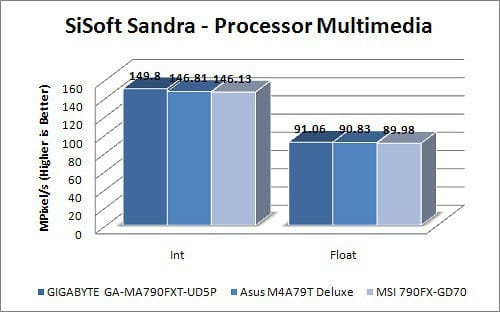Plugging It All In

With everything setup, it was time to start plugging in my peripherals. The MSI 790FX-GD70 motherboard provides a fairly standard set of ports for hooking things up. There’s two discrete PS/2 ports for old school mice and keyboards, as well as a large collection of USB ports. Audio output is what you would come to expect from a 5.1 channel onboard chipset, with analogue, and optical and coaxial digital outputs present. MSI even went down an uncommon road with implementing two LAN ports, which both support GigE speeds. The increasingly common eSATA port brings up the rear.
The Test System
To test the MSI board, we installed our standard AMD test rig on it. This will allow us to make our direct comparisons to the other 790FX boards we’ve reviewed much easier. It should be noted that the 790FX-GD70 is also part of the “Dragon: Reloaded” platform.
Here are the other components used in testing:
- AMD Phenom II X4 955 Black Edition CPU
- Corsair XMS3 DHX 4GB DDR3-1600 Dual Channel Memory Kit
- GIGABYTE GV-R489-1GH-B Radeon HD 4890 Video Card Review
- Western Digital VelociRaptor 300GB 10000rpm SATA2 Hard Drive
- HighSpeed PC Top Deck Tech Station
- Lian Li MAXIMA Force Extreme PS-A650GB 650W Power Supply
Boards tested against:
We ran the MSI board through our collection of synthetic and real world tests to see how it measures up to the other boards. These tests include a few Futuremark programs, SiSoft Sandra, and a couple games, and are meant to directly compare performance in areas like CPU performance, memory, I/O, and gaming.
The I/O tests are fairly important, as we’ve been having some strange variances in performance from the 790FX chipset that will be covered in a separate article coming soon. For now let’s see how the 790FX-GD70 stacks up.
Sitting Down With Sandra

Our round of benchmarking started with SiSoftware Sandra. This program features a series of stress tests and benchmarks that can be used to determine if a component is functional and how well it performs. We started with some CPU tests, to see how each motherboard performs with the same hardware. For the Processor Arithmetic test the result is determined by measuring the time it takes to perform some sequences of instructions. In this test the MSI board performed is a fashion very similar with the ASUS and GIGABYTE boards. There was a minor performance burst in Dhryston testing, but nothing statistically relevant.

Much like the Arithmetic test, the Multimedia test is fairly self explanatory in it’s name. This benchmark generates a picture (640×480) of the well-known Mandelbrot fractal, using 255 iterations for each data pixel, in 32 colours. SiSoftware claims that this is more a real world test of multimedia capabilities then a sythetic benchmark. This test is supposed to place stress on and objectively rate how different algorithms (SSE3, 3DNow!, etc) affect CPU performance. The results from this test were even more dull and flat then the first CPU test we performed. Yes the MSI board did post lower scores then the other boards, but the results are so close together as to be completely moot. With no clear winner determined yet, things are looking OK for the inexpensive MSI board.
